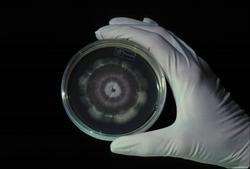Genetic engineering-
How?
For this science, all the work happens
in test tubes.
First the gene from species A that we want to insert into species B is isolated.
This is done by first isolating DNA, then, using appropriate methods, determining
its sequence (base sequence).
Once we know this, and we know which genes to use, specific enzymes are used
to cut out the gene that we are interested in. After purification we have a
copy of the gene we want. It can then be studied, multiplied and subsequently
used for insertion into another species.
There are two ways of getting a gene into a cell of species B:
- The "SHOTGUN TECHNIQUE",
also known as "bio-ballistics," which blindly shoots masses of tiny
gold particles coated with the gene into a plate of plant cells, hoping to
land a hit somewhere in the cell's DNA.
- The use of a vector, usually a
bacterial plasmid or a virus, to carry the gene into the nucleus of cell B.
 Plasmids
are small rings of DNA found in bacteria. They only have a limited number of
genes and hence their sequence is very easy to determine. As they replicate
quickly it is simple to study them.
Plasmids
are small rings of DNA found in bacteria. They only have a limited number of
genes and hence their sequence is very easy to determine. As they replicate
quickly it is simple to study them.
To insert our gene A into the plasmid we need to do the following:
- Take a large number of a known
plasmid and place it into a test tube.
- Add a cutting enzyme: an enzyme
that recognises a certain base sequence and will cut the DNA strand at a particular
point.
- Leave this so that the enzyme
can cut all the DNA, then purify it.
- Add the gene we want to incorporate
into the cell B, i.e. gene A. Gene A will add to the openend plasmid ring.
- Add an enzyme called ligase, which
will join the ends together and reform a plasmid with our gene in.
- Put the plasmid back into bacteria
and leave these to grow and multiply.

But now we need to work out which
bacteria contain the modified plasmid. This is done by using plasmids containing
a marker gene, usually a gene that makes bacteria resistant to an antibiotic.
The culture is then treated with this antibiotic and all the cells without the
plasmid die whilst the others mutliply.
Conclusion
 Plasmids
are small rings of DNA found in bacteria. They only have a limited number of
genes and hence their sequence is very easy to determine. As they replicate
quickly it is simple to study them.
Plasmids
are small rings of DNA found in bacteria. They only have a limited number of
genes and hence their sequence is very easy to determine. As they replicate
quickly it is simple to study them. 